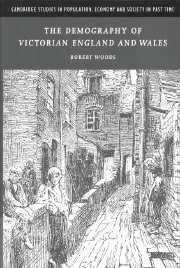Book contents
- Frontmatter
- Contents
- List of figures
- List of tables
- Preface
- 1 Bricks without straw, bones without flesh
- 2 Vital statistics
- 3 Whatever happened to the preventive check?
- 4 Family limitation
- 5 The laws of vitality
- 6 Mortality by occupation and social group
- 7 The origins of the secular decline of childhood mortality
- 8 Places and causes
- 9 The demographic consequences of urbanisation
- 10 The transformation of the English and other demographic regimes
- 11 Conclusions and unresolved conundrums
- Bibliography
- Index
- Cambridge Studies in Population, Economy and Society in Past Time
4 - Family limitation
Published online by Cambridge University Press: 07 August 2009
- Frontmatter
- Contents
- List of figures
- List of tables
- Preface
- 1 Bricks without straw, bones without flesh
- 2 Vital statistics
- 3 Whatever happened to the preventive check?
- 4 Family limitation
- 5 The laws of vitality
- 6 Mortality by occupation and social group
- 7 The origins of the secular decline of childhood mortality
- 8 Places and causes
- 9 The demographic consequences of urbanisation
- 10 The transformation of the English and other demographic regimes
- 11 Conclusions and unresolved conundrums
- Bibliography
- Index
- Cambridge Studies in Population, Economy and Society in Past Time
Summary
In broad terms, demographers and social historians have adopted two forms of approach in their efforts to explain the origins and causes of the historical fertility transition. The first attempts some test of theory, however conceived or executed. The second approach is more empirically oriented; it seeks to identify regularities or patterns and to make generalisations therefrom. The application of these approaches to the study of family limitation has led to a plethora of published pieces each yielding their own particular insights. But in many respects we seem to be no closer to solving the various problems involved than was David Glass when he took up the challenge more than sixty years ago. Why should this be so?
As a preliminary to detailed considerations of individual approaches in the remainder of this chapter, some general observations are in order. First, it now appears clear that England and Wales did not display the pattern of demographic change illustrated in classical transition models. This much at least was established in chapter 1. Rather, fertility increased in the late eighteenth and early nineteenth centuries and declined thereafter until the 1940s with only a short interruption in the 1850s and 1860s. Mortality declined slowly during the first half of the nineteenth century, but the pace of change quickened, especially when infant mortality began its rapid secular decline from 1899/1900. The protracted fertility transition was influenced by two rather different processes.
- Type
- Chapter
- Information
- The Demography of Victorian England and Wales , pp. 110 - 169Publisher: Cambridge University PressPrint publication year: 2000



